
Types of Glasses
With various types of glasses, choosing the perfect pair might be overwhelming. This article helps you understand all the different types of glasses, lenses and frames available. Use this as a starting point to see all the options and find the perfect eyewear.
Types of prescription glasses
Firstly, you need to know if you need an eye prescription for your glasses. Whether it’s for reading, working, or leisure, many people need eyeglasses to help correct their vision and see better. Before shopping for a new pair, make sure your eye prescription is still valid, or visit your optometrist for a check-up.
Our eyesight naturally changes as we age, and sometimes it can change while we are still young. These changes can depend on genetics, illnesses, or a misshaped cornea. For each type of refractive error, there is a pair of prescription glasses to help correct it.
Single vision glasses

Single Vision glasses are the most common type of glasses. “Single Vision” means that the lenses only have one type of vision correction, so one focal length. They help correct refractive errors such as myopia, hyperopia and astigmatism, but only for distance or near vision, never both.
Bifocal glasses

Bifocal glasses have lenses with separate prescription zones for near and far vision. At the top, you’ll have your distance correction, while your near vision correction is towards the bottom. These lenses have a distinct line between each value which causes an image to jump when the eye moves from a far distance to a near one. An image jump is when the object appears to jump into view closer than it is when viewing through the near segment.
Progressive glasses

Unlike bifocals, progressive glasses help correct all focal points without visible lines. Each area transitions from one visual correction to another, allowing smoother vision. The top of the lens is adapted for distance vision and gradually increases in power into the intermediate prescription, which corrects anything at an arm’s length away. Finally, it increases in power towards the bottom, designed for reading or other “close-up” tasks, like checking a price tag or using your smartphone.
Other types of glasses
Reading glasses
Reading glasses are a type of single vision lenses, but they do not always require a prescription and are available OTC (over the counter), even at local supermarkets. These do not correct your vision but simply magnify things to make them bigger. They also do not correct astigmatism or amblyopia (a difference of power between the two eyes), so you can only get them in the same power for both eyes (R+L). Reading glasses help you see things close up, like reading a book or looking at your phone or computer.
The power value of reading glasses can start low (+1) and reach higher prescriptions (+4). There are different types of reading glasses which you can read more about here to choose the best one for you. In any case, we recommend consulting your opticians when experiencing visual discomfort before buying any glasses.
Blue Light Glasses
Blue light blocking glasses are designed to filter out the blue light rays commonly released from digital screens. The filter on the surface of these lenses blocks out an estimated 65% of blue light rays. This will help prevent eyestrain symptoms caused by blue light that can irritate the eyes. If you use digital technology for socialising, fun, or work and have noticed changes in your eyes or health, then blue light glasses may be what your eyes need.
Safety Glasses
Safety glasses are available to anyone without any prescription and help protect your eyes from external factors that may hinder your vision. Safety goggles are a must if working in an environment surrounded by hazardous elements, but they can also be used in other contexts for work or leisure.
Sunglasses
Sunglasses are also glasses that we can use with or without a prescription to see better and protect our eyesight. Similar to prescription glasses, sunglasses can also come with various lenses and filters that work best with specific situations. If you’re looking for something practical that combines your glasses and sunglasses or don’t like wearing contact lenses, you may want to consider the following:
- Prescription sunglasses
- Clip-ons
- Photochromic glasses
Types of lenses for glasses
Depending on a person’s eye needs and preferences, different types of lenses work best with prescription glasses.
- Glass
- Plastic
- Polycarbonate
- Trivex & High trivex
You can also combine many lenses with protective coatings to reduce damage to your eyewear and eyesight. Alongside quality lenses, specific frames are also available for all glasses.
Types of glasses frames
Even frame materials and designs can impact your vision and comfort. Some are heavier than others or even bulkier, while others are more lightweight and look nearly invisible.
Frame types
There are three main types of glasses frames:
- Full-rim: Full-rim frames completely outline the lens. They are the most durable frame type.
- Rimless: Rimless glasses, also known as frameless eyeglasses, are glasses with no frame. The nose bridge connects the lenses, and the temples are directly attached to the lenses. This frame type is the most delicate one.
- Semi-rimless: Semi-rimless frames cover the top part of the lenses.
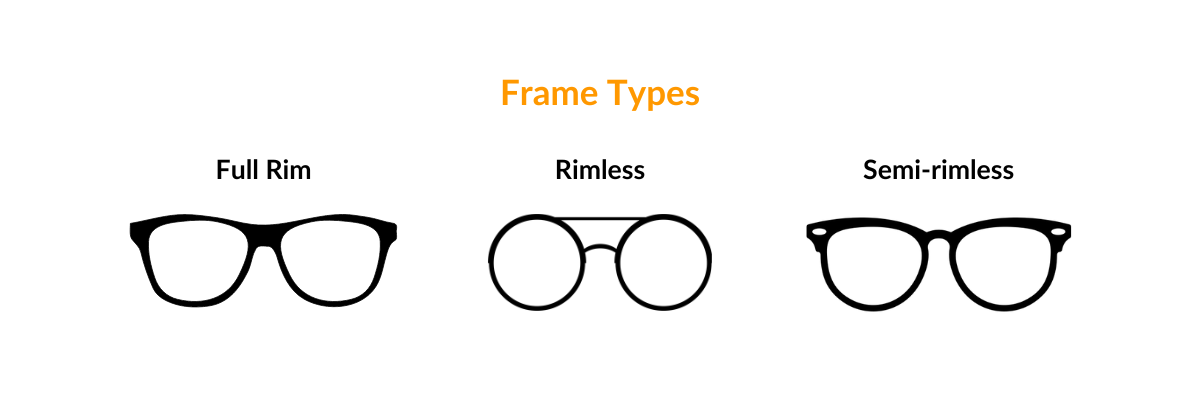
Frame materials
There are four main types of material used for glasses frames:
- Acetate: Acetate glasses are a low-price option, much like plastic glasses, with the benefits of greater durability and closer related to metal frames.
- Metal: Aside from their elegant aesthetic benefits, metal frame glasses are a durable material that isn’t likely to break easily with proper care.
- Plastic: Plastic is the most affordable option. Plastic frames make for a great second pair of backup glasses. Plastic is also lightweight and resistant to chemical corrosion.
- Titanium: While more expensive than other materials, titanium glasses are the most resistant. They are flexible, hypoallergenic and lightweight for a comfortable fit.
- Wood: Wood frame glasses are durable and resistant as well as eco-friendly. Aside from this, they offer a unique aesthetic quality to add to your style.
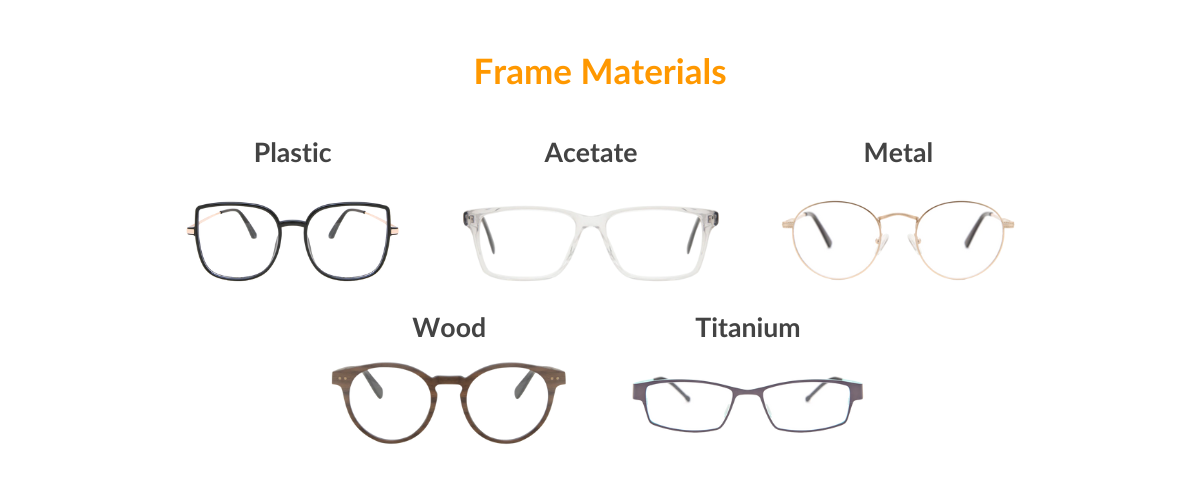
Frame shapes
Glasses come in a variety of shapes, and this is excellent news! You can find the one that will emphasise your best features and adapt to the type of prescription you need. Consult this infographic and then read on to learn how to match your face shape with the right frame.
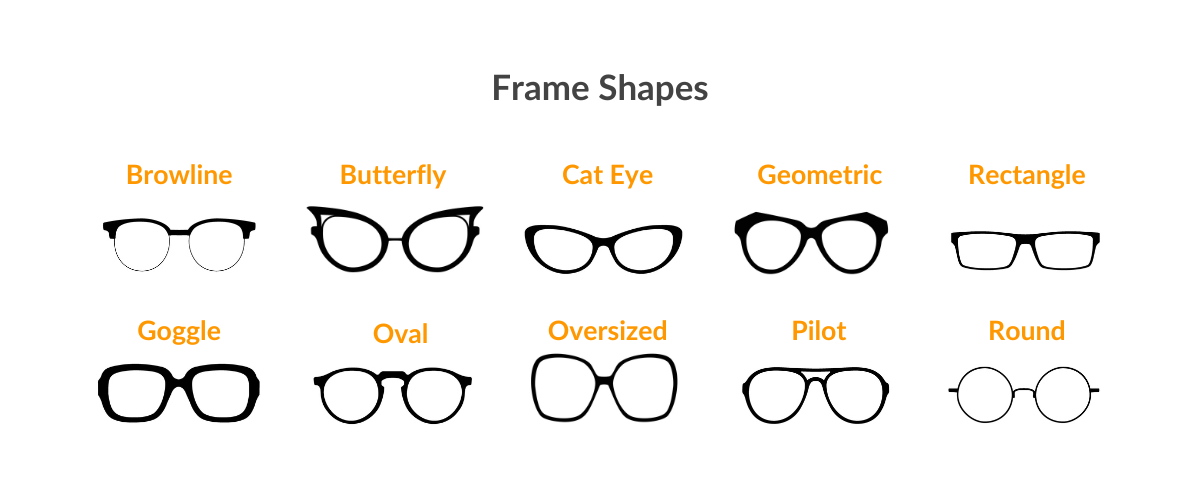
The frame size is also important when choosing the type of glasses you want. If your specs do not fit comfortably on your face, you’ll experience discomfort, such as glasses slipping down or tight frames.
What type of glasses fits my face?
With all these frame types, styles and shapes, there are hundreds of options to choose from. One way to start narrowing down your choices is to determine which face shape you have. Watch this tutorial to find your face shape and which glasses fit you best!
What type of glasses should I get?
Whether you need to read, see distant objects, or look cool, the type of glasses you need depends on your eyes and lifestyle. Firstly, if you need vision correction, make sure your prescription is up to date. Once you have that, read about the best lenses you can get or ask for online advice from one of our opticians.
In this article, we’ve covered the different types of prescription and non-prescription glasses and some tips for choosing the best pair for you. We’ve also introduced the various lens materials, coatings and frames from which prescription glasses and sunglasses can benefit.
Remember that before you buy any prescription glasses, you should have regular eye tests by your optometrist or eye doctor. At SmartBuyGlasses, you can find optical advice and trendy and quality eyewear to satisfy your needs and lifestyle.
Types of Glasses
With various types of glasses, choosing the perfect pair might be overwhelming. This article helps you understand all the different types of glasses, lenses and frames available. Use this as a starting point to see all the options and find the perfect eyewear.
Types of prescription glasses
Firstly, you need to know if you need an eye prescription for your glasses. Whether it’s for reading, working, or leisure, many people need eyeglasses to help correct their vision and see better. Before shopping for a new pair, make sure your eye prescription is still valid, or visit your optometrist for a check-up.
Our eyesight naturally changes as we age, and sometimes it can change while we are still young. These changes can depend on genetics, illnesses, or a misshaped cornea. For each type of refractive error, there is a pair of prescription glasses to help correct it.
Single vision glasses
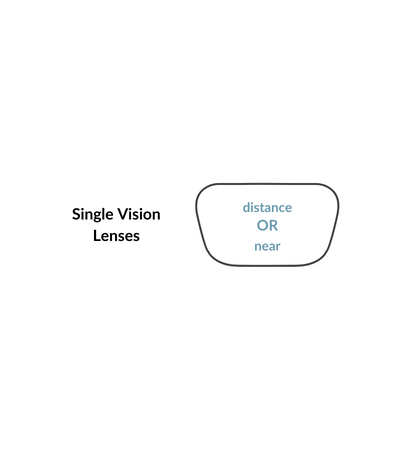
Single Vision glasses are the most common type of glasses. “Single Vision” means that the lenses only have one type of vision correction, so one focal length. They help correct refractive errors such as myopia, hyperopia and astigmatism, but only for distance or near vision, never both.
Bifocal glasses

Bifocal glasses have lenses with separate prescription zones for near and far vision. At the top, you’ll have your distance correction, while your near vision correction is towards the bottom. These lenses have a distinct line between each value which causes an image to jump when the eye moves from a far distance to a near one. An image jump is when the object appears to jump into view closer than it is when viewing through the near segment.
Progressive glasses
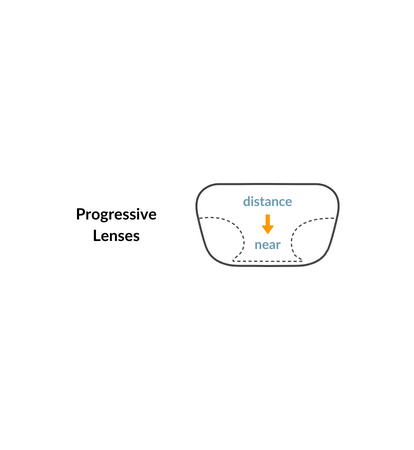
Unlike bifocals, progressive glasses help correct all focal points without visible lines. Each area transitions from one visual correction to another, allowing smoother vision. The top of the lens is adapted for distance vision and gradually increases in power into the intermediate prescription, which corrects anything at an arm’s length away. Finally, it increases in power towards the bottom, designed for reading or other “close-up” tasks, like checking a price tag or using your smartphone.
Other types of glasses
Reading glasses
Reading glasses are a type of single vision lenses, but they do not always require a prescription and are available OTC (over the counter), even at local supermarkets. These do not correct your vision but simply magnify things to make them bigger. They also do not correct astigmatism or amblyopia (a difference of power between the two eyes), so you can only get them in the same power for both eyes (R+L). Reading glasses help you see things close up, like reading a book or looking at your phone or computer.
The power value of reading glasses can start low (+1) and reach higher prescriptions (+4). There are different types of reading glasses which you can read more about here to choose the best one for you. In any case, we recommend consulting your opticians when experiencing visual discomfort before buying any glasses.
Blue Light Glasses
Blue light blocking glasses are designed to filter out the blue light rays commonly released from digital screens. The filter on the surface of these lenses blocks out an estimated 65% of blue light rays. This will help prevent eyestrain symptoms caused by blue light that can irritate the eyes. If you use digital technology for socialising, fun, or work and have noticed changes in your eyes or health, then blue light glasses may be what your eyes need.
Safety Glasses
Safety glasses are available to anyone without any prescription and help protect your eyes from external factors that may hinder your vision. Safety goggles are a must if working in an environment surrounded by hazardous elements, but they can also be used in other contexts for work or leisure.
Sunglasses
Sunglasses are also glasses that we can use with or without a prescription to see better and protect our eyesight. Similar to prescription glasses, sunglasses can also come with various lenses and filters that work best with specific situations. If you’re looking for something practical that combines your glasses and sunglasses or don’t like wearing contact lenses, you may want to consider the following:
- Prescription sunglasses
- Clip-ons
- Photochromic glasses
Types of lenses for glasses
Depending on a person’s eye needs and preferences, different types of lenses work best with prescription glasses.
- Glass
- Plastic
- Polycarbonate
- Trivex & High trivex
You can also combine many lenses with protective coatings to reduce damage to your eyewear and eyesight. Alongside quality lenses, specific frames are also available for all glasses.
Types of glasses frames
Even frame materials and designs can impact your vision and comfort. Some are heavier than others or even bulkier, while others are more lightweight and look nearly invisible.
Frame types
There are three main types of glasses frames:
- Full-rim: Full-rim frames completely outline the lens. They are the most durable frame type.
- Rimless: Rimless glasses, also known as frameless eyeglasses, are glasses with no frame. The nose bridge connects the lenses, and the temples are directly attached to the lenses. This frame type is the most delicate one.
- Semi-rimless: Semi-rimless frames cover the top part of the lenses.

Frame materials
There are four main types of material used for glasses frames:
- Acetate: Acetate glasses are a low-price option, much like plastic glasses, with the benefits of greater durability and closer related to metal frames.
- Metal: Aside from their elegant aesthetic benefits, metal frame glasses are a durable material that isn’t likely to break easily with proper care.
- Plastic: Plastic is the most affordable option. Plastic frames make for a great second pair of backup glasses. Plastic is also lightweight and resistant to chemical corrosion.
- Titanium: While more expensive than other materials, titanium glasses are the most resistant. They are flexible, hypoallergenic and lightweight for a comfortable fit.
- Wood: Wood frame glasses are durable and resistant as well as eco-friendly. Aside from this, they offer a unique aesthetic quality to add to your style.
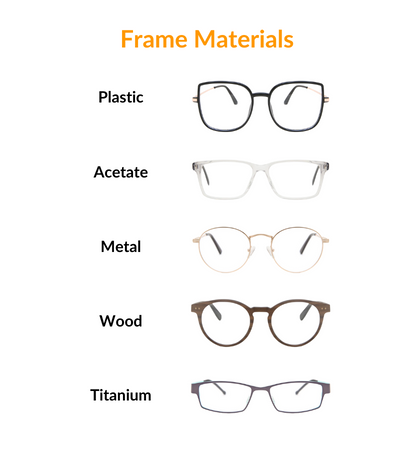
Frame shapes
Glasses come in a variety of shapes, and this is excellent news! You can find the one that will emphasise your best features and adapt to the type of prescription you need. Consult this infographic and then read on to learn how to match your face shape with the right frame.
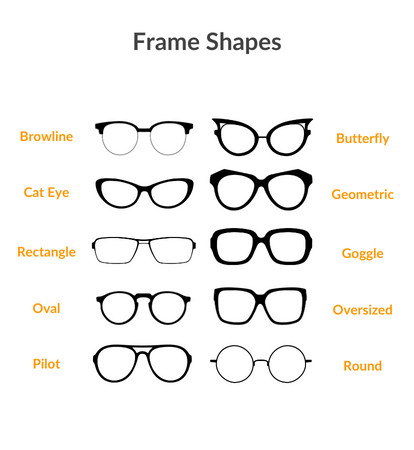
The frame size is also important when choosing the type of glasses you want. If your specs do not fit comfortably on your face, you’ll experience discomfort, such as glasses slipping down or tight frames.
What type of glasses fits my face?
With all these frame types, styles and shapes, there are hundreds of options to choose from. One way to start narrowing down your choices is to determine which face shape you have. Watch this tutorial to find your face shape and which glasses fit you best!
What type of glasses should I get?
Whether you need to read, see distant objects, or look cool, the type of glasses you need depends on your eyes and lifestyle. Firstly, if you need vision correction, make sure your prescription is up to date. Once you have that, read about the best lenses you can get or ask for online advice from one of our opticians.
In this article, we’ve covered the different types of prescription and non-prescription glasses and some tips for choosing the best pair for you. We’ve also introduced the various lens materials, coatings and frames from which prescription glasses and sunglasses can benefit.
Remember that before you buy any prescription glasses, you should have regular eye tests by your optometrist or eye doctor. At SmartBuyGlasses, you can find optical advice and trendy and quality eyewear to satisfy your needs and lifestyle.































